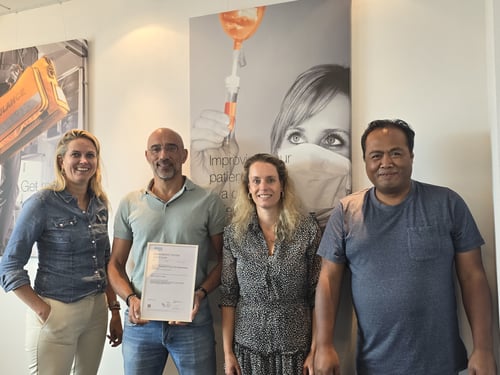To understand and improve any system, we must look at its successes and failures. Whether its life and death, healing or inadvertently injuring patients, the stakes could not be higher.
Our healthcare providers and staff undertake the complex work of medical care under pressure of time constraints, and in environments where priorities often shift. In addition, these individuals must adhere to hundreds of internal policies and external regulations guiding their actions. Despite all of our best efforts to ensure patient safety, incidents and patient harm occur.
Research into why incidents occur and whether providers and staff report them in a timely way—or at all—is not new. But it’s important for quality and safety leaders at healthcare organizations of all types and sizes to periodically look anew at their data.
For example, is blame or fear of punishment hindering reporting at your facility? Or is something simpler the reason—like a lack of time for providers to stop and record the details of an event? And what about ease of access to a tool to report an incident?
Assessing the potential barriers to incident reporting in a healthcare organization
In this blog, we review some of the wide-ranging reasons that keep providers and staff from reporting incidents. Every facility is different, even across integrated healthcare systems, with numerous factors acting as barriers to reporting. Consider that your leadership culture, the structure of departments and care-delivery teams, and other reasons to report, or not to report, may come into play. In other words, “if you’ve seen one facility, you’ve seen one facility.”
8 barriers to incident reporting in healthcare
Assess the potential barriers to reporting in your organization on a regular basis, beginning with the examples below, and adding your own factors to monitor. Or watch the short summary video:
Barrier 1: Worry over legal ramifications
Legal reprisal over a reported incident is a common fear among many healthcare workers and staff. Start to alleviate this fear by educating all parties about what is done with any reported data. A standardized incident report form completed properly, stating the facts, should not raise concerns about how it might be used, should legal action occur.
In particular, focus training on:
- What to include in a report, and what not to include
- How to concentrate on the facts and how to handle second-hand information
- How to frame the relevant details, avoiding opinions and blame
The bottom line is to let staff know that if an investigation occurs, and they are called to speak about a reported incident, their best course of action is to speak honestly and factually about what occurred.
Barrier 2: Blame and shame culture, guilt, fear of punishment
Historically, a culture of blame and shame and a fear of reprisal—including job loss or the loss of license—were seen as the biggest factors preventing staff from reporting incidents.
Some healthcare organizations have made strides in moving away from such attitudes by successfully adopting “Just Culture,” “Safety II,” or other initiatives. Their aim is to assure staff that most errors are due to flawed systems, not individual negligence. Unfortunately, evidence suggests that most organizations still struggle to embrace a blame- and guilt-free environment, making ongoing work to achieve such an environment a necessity.
Barrier 3: A lack of time to report
Imagine the typical nurse working a 12-hour shift treating patients in your facility. Depending on the unit or department and your geographic location, the nurse-to-patient ratio may range from 1:2 to 1:6 or more. How easy—or difficult—does your organization make it for that nurse to stop and report the crucial details of an incident while they are fresh?
Giving staff the time and tools they need to complete a report at the time of the incident, rather than at the end of their long shift, is essential for promoting safety and compliance. But it also shows providers and staff that there is nothing more important than their perspective to help the organization learn from mistakes in the current system design.
Barrier 4: No easy reporting system
Today’s incident management methods require more than tracking incidents or near incidents at the hospital bedside. As practitioners increasingly administer care and services in outpatient, ambulatory, or retail clinics; in specialty centers; and via telemedicine, our safety and quality improvement tools must adapt. In other words, we must follow the patient and provider to prevent harm.
As a result, it is best practice to use automated, online forms that allow staff and others to quickly report any (near) incident. Make the forms easy to use and accessible by computer, tablet, or smartphone to increase participation and compliance, and to capture details that could become lost as time passes.
Barrier 5: No trust in follow-up/repeated reports with no follow-up
Let’s return to our example of the nurse and imagine that he has taken the time to report two separate incidents wherein he has firsthand knowledge. The first was a patient fall and the second was a medication error. However, he does not hear back from the administration and has no idea about what actions, if any, have been taken regarding the reports.
A healthcare organization that fails to follow-up on reported incidents or to communicate effectively about subsequent actions and resolutions has failed in its duty to protect patients, staff, and the organization from harm and liability.
Learn more about incident management on our special topic page.
Barrier 6: Already reported the same event in the past
Ultimately, a sound incident reporting system enables staff and management to be in sync regarding which improvements to prioritize, once risks within the organization have been identified. Every staff member then becomes challenged to do things better and/or differently in their department once it’s determined whether more time, money, people, or material should be made available to alleviate the risk.
But that cannot happen where there’s a failure to act amid patterns of repeated risk. Reports of incidents that repeat should be red flags. Staff who continue to report the same or similar incidents can become demoralized, increasing the risk they will not report in the future.
Barrier 7: Details are lost with time
When (near) incidents and staff response to incidents aren’t accurately captured, the costs are high for individual practitioners as well as the healthcare system. Risks include patient harm, regulatory noncompliance, malpractice, and poor public relations. Accurate documentation can make the difference in avoiding a missed improvement opportunity or failing to recognize and remedy any errors that have already occurred.
Ensure that your organization protects the accuracy and permanency of incident information. Participants should be able to:
- Provide lengthy descriptions in open-ended response boxes as well as respond using yes/no questions
- Include supporting details in the form of attachments, such as photos, videos, or voice recordings
- See only relevant questions based on the (near) incident type that is being reported
- Remain anonymous if they choose, and if the policy allows
Barrier 8: Lack of encouragement from administration and/or colleagues
Who’s accountable for capitalizing on quality improvement and patient safety opportunities in your healthcare organization?
- The Quality Improvement Director
- The Chief Nursing Officer
- Patients
- All of the above
- None of the above
Modern methods of shared accountability for healthcare quality improvement carve out a role for everyone in effecting positive change, making 5 the correct choice.
In addition to a basic willingness for all parties to be open and upfront, it requires a structured top-down approach that directly involves top management in patient safety efforts. For example, consider having quality administrators and senior leaders communicate with bedside caregivers about how their daily efforts provide the foundation of organizational improvement initiatives. The more forums that bring together leadership’s safety messages with on-the-floor teams’ actions, the better. Such opportunities promote two-way learning, foster understanding, and increase staff’s confidence in knowing that their reporting efforts matter.
Encouraging and instructing clinicians and staff about how and when to file incident reports is just the first step in ensuring that your entire healthcare team is pulling in the same direction toward safer care.
Use our eBook to develop your own incident reporting forms
Download the eBook Blueprints for reporting forms to learn to develop your own incident reporting forms. Find a unique way to cope with each individual incident reporting barrier that best suits your organization.





